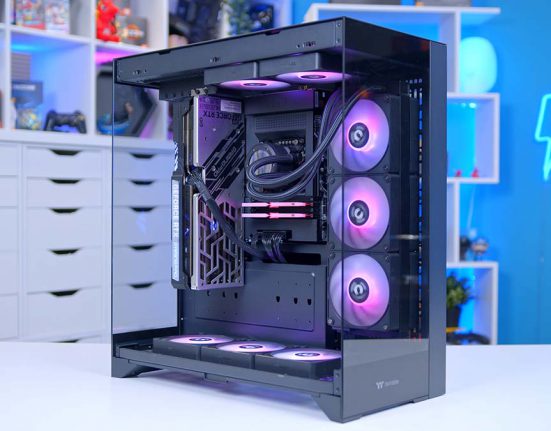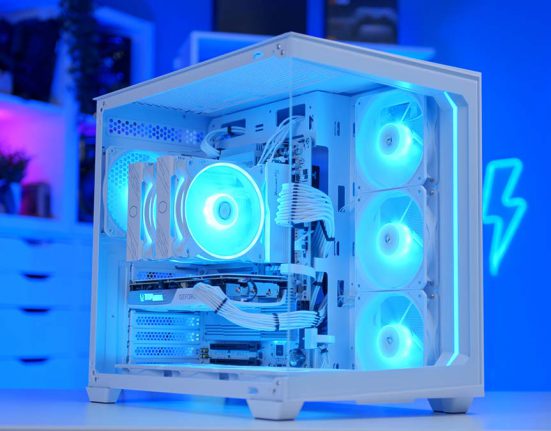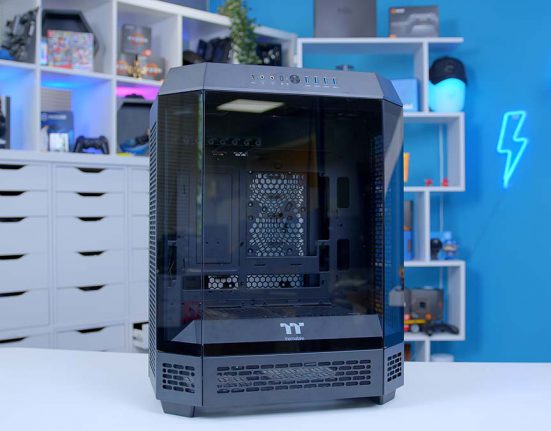The Thermaltake Tower 300 is a unique PC case that allows for a virtually unparalleled view into your PC build, while theoretically limiting the impact on airflow. It does so in a fairly compact form factor, and with a design that we haven’t really seen from any other manufacturer.
This case is actually Thermaltake’s third iteration of ‘The Tower’ range, opening up the internal space, and improving functionality further over the 100 and 200 models. This chassis offers room for a 420mm liquid cooler, Micro-ATX motherboards, and 400mm of clearance for large graphics cards.
But is The Tower 300 a worthwhile contender when compared to other small chassis on the market, and does it sufficiently improve on its predecessors? We’ll be answering these questions in this review, by putting The Tower 300 through a range of tests to assess the specs, design, build quality, and the various features on offer.
Specifications
The Tower 300 comes with an impressive list of specs, with a wide array of colours to choose from too. The Tower 300 case has 3 USB ports on offer, with all of them being USB 3.0 or higher. It would be great to see more ports to choose from, as The Tower 300 does restrict access to the rear IO. This case also features two separate audio jacks for a microphone and headset, allowing you to connect up a dedicated pair of headphones or mic.
On the clearance front, the Tower 300 provides a huge amount of space, despite its smaller footprint. There is 400mm of GPU clearance to play around with, and up to 210mm of height for a CPU air cooler.
The Tower 300 does support 420mm radiators, which is great to see, but you are limited to where you can install it, which is the side panel of this chassis. Fan support however is very solid, with the Tower 300 offering space for 8 140mm fans in total.
| Specification | The Tower 300 |
|---|---|
| Form Factor | Micro Tower |
| Motherboard Support | ITX, M-ATX |
| Front IO | 1 x USB 3.2 Gen2 Type-C 2 x USB 3.0 Type-A 2 x 3.5mm Audio Jacks |
| PCI-E Slots | 4 |
| Colour | Black Snow White Hydrangea Blue Turquoise Racing Green Matcha Green Bumblebee Yellow |
| Max. Clearance | 210mm Cooler Height 400mm GPU Length 220mm PSU Length |
| Drive Support | Up to 3 x 2.5 inch Up to 3 x 3.5 inch |
| Fan Support | Side: 3 x 140mm Top: 2 x 140mm Rear: 2 x 140mm PSU Cover: 1 x 140mm |
| Radiator Support | Side: 420mm |
| Preinstalled Fans | 2 x 140mm |
| MSRP | $149.99 |
Thermaltake The Tower 300 Design
Thermaltake’s The Tower 300 is a Micro-ATX Tower chassis with a seamless set of tempered glass panels that line the front of the case. It comes in a huge range of colours, which includes the standard black and white options, along with variants of blue, green, and even yellow. We’re taking a look at the black version in this review, but appreciate the vast range of options available.
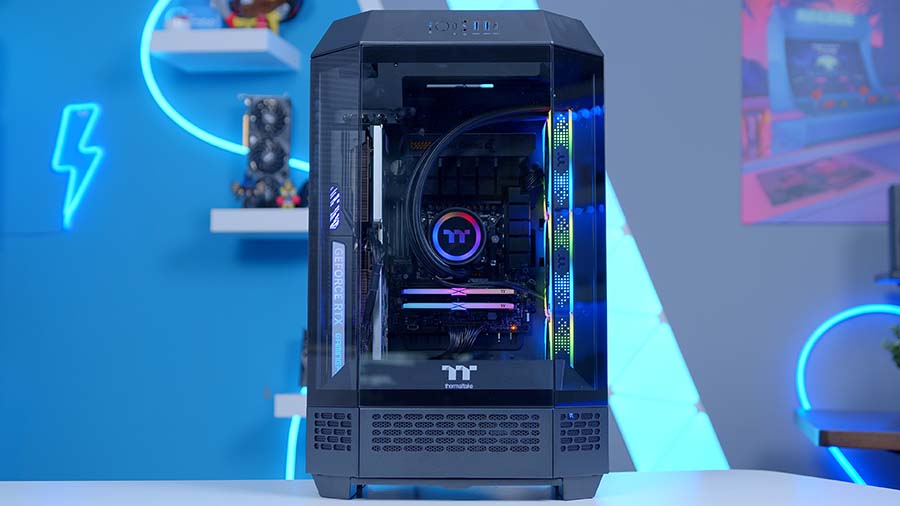
The main focus of The Tower 300 is to provide more ventilation and space, while keeping the size of the chassis small, relative to Mid-Tower options. This case has a mass of ventilation around the entire chassis, which includes the front, side, rear, and top panels.
The PSU shrouding also has ventilation underneath, allowing air to flow freely through the case. This also comes in handy if you’ve decided to pick up the optional stand accessory, which allows you to display The Tower 300 horizontally. Each set of vents has a dedicated dust filter, minimising any airflow blockages as the fans circulate air around the chassis.
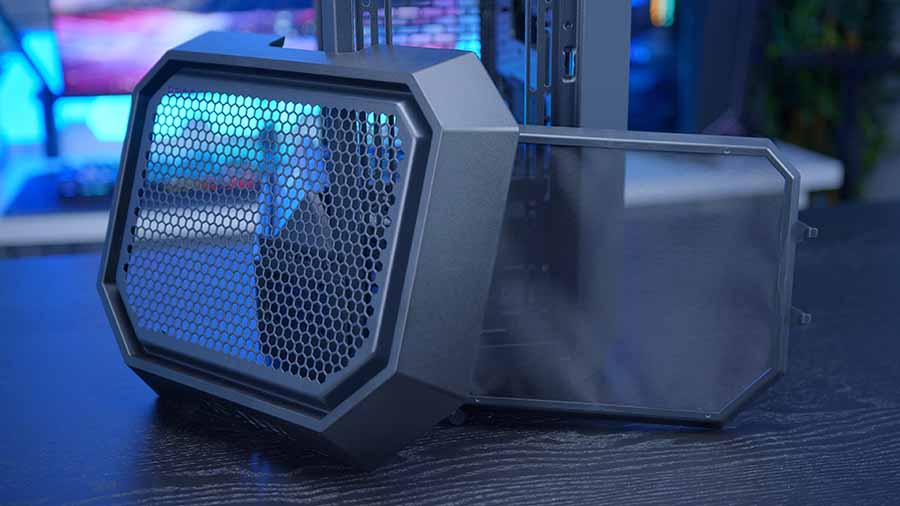
The Tower 300 comes with 3 tempered glass panels at the front of the case, providing a full unhindered view of your PC build. Thermaltake has prioritised ease of use with this chassis, so the removable panels are entirely tool-less, which makes the building process much simpler.
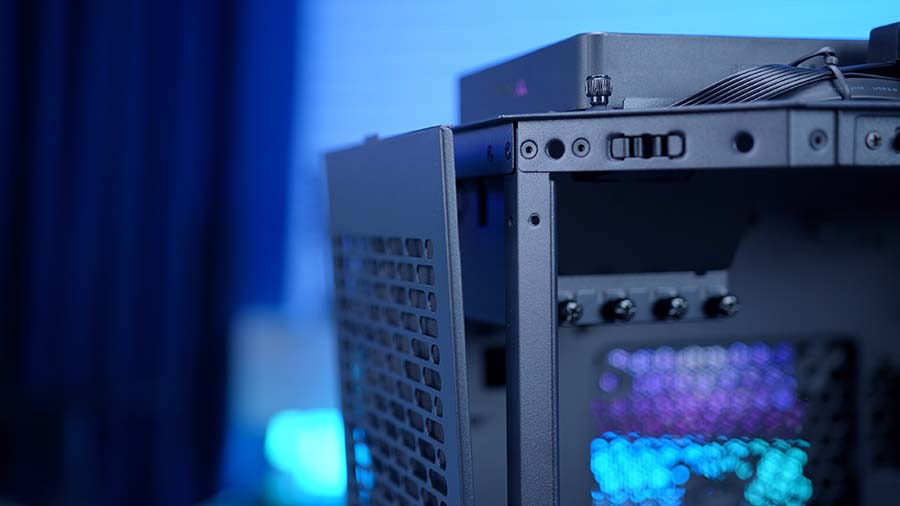
Thermaltake have done a good job when it comes to the rear of the chassis. There’s space for an extra fan here, with support for both 120mm and 140mm sizes. Alternatively, there’s also space for 3 2.5″ drives, or 3 3.5″ drives, accommodating those with SATA-based devices.
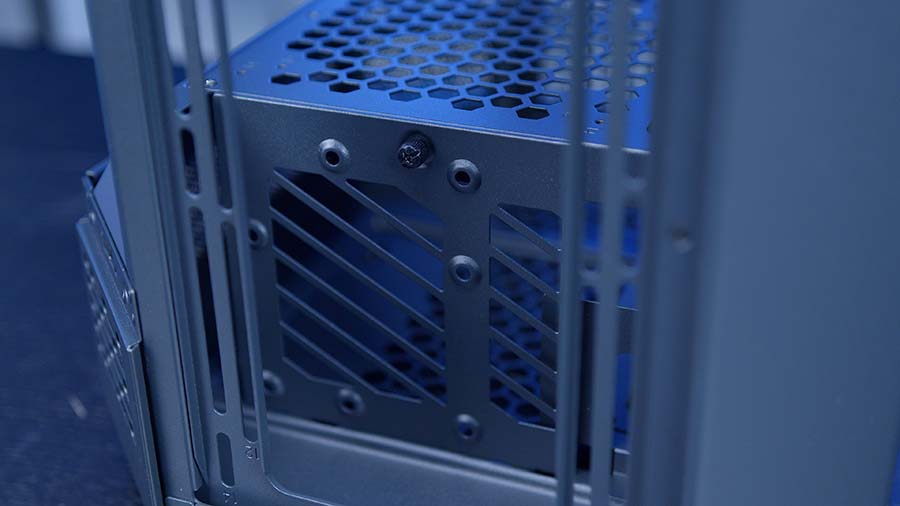
Cable management is pretty compact, with fewer channels to cram any cables into. However, there’s a mass of cut-outs for varying power connectors to fit through underneath and around the motherboard tray.
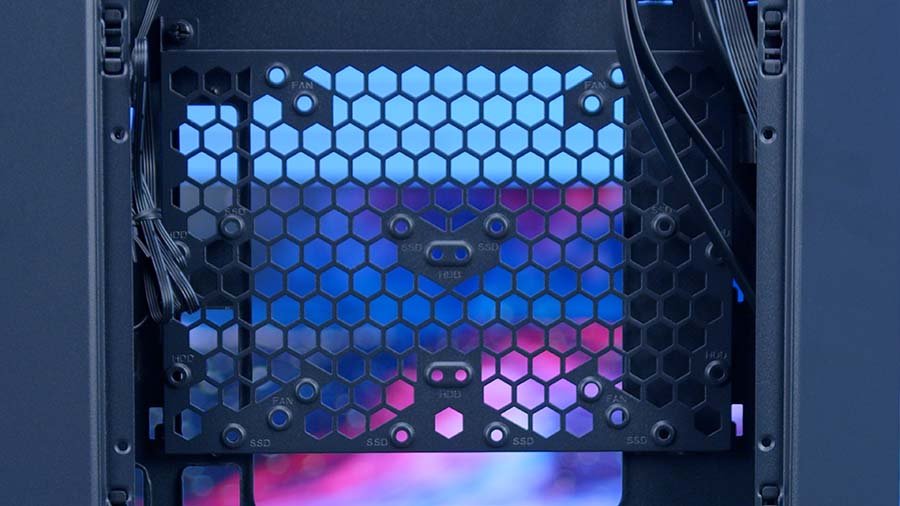
At the top of The Tower 300 are two pre-installed 140mm CT140 fans. These can be accessed by simply removing the top plastic shrouding which also covers the IO.
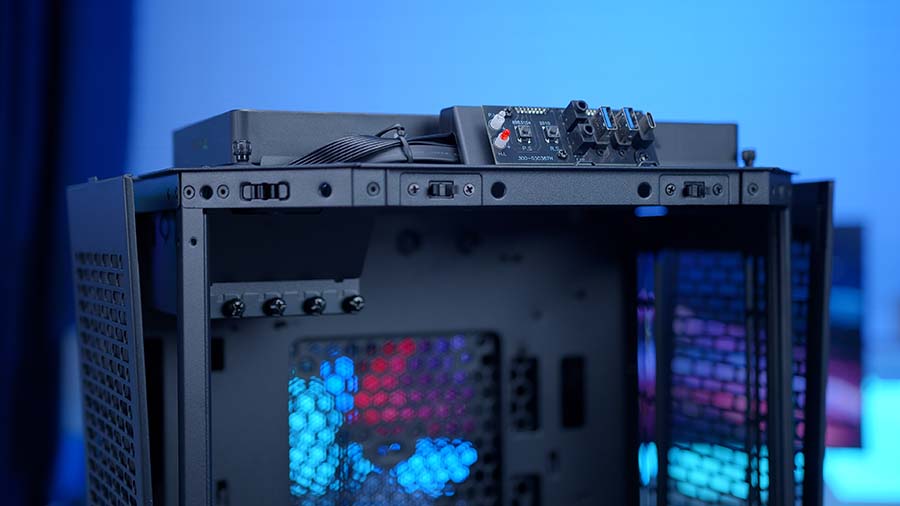
The front IO includes 3 USB ports to choose from, of which there are 2 USB 3.0 Type-A ports, and a USB 3.2 Gen2x2 Type-C port. The Tower 300 also comes with two dedicated 3.5mm audio jacks, one for a headset, and the other for a microphone.
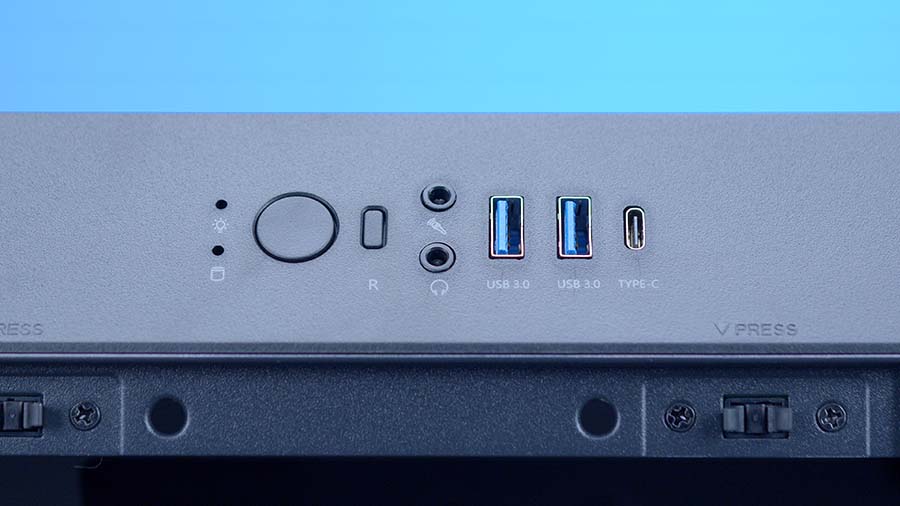
Admittedly, I do feel that for a case that focuses on ventilation, The Tower 300 should come with more fans, as this saves the buyer from having to spend any extra cash outside of their budget. This aside, the affordable price point does make the fact that you’re having to spend a bit more on fans easier to swallow.

Aesthetically, I think the Tower 300 is one of the better looking small form factor cases that we’ve taken a look at. The tool-less tempered glass panels provide you with a fully unrestricted view of your components, allowing you to show off your build. The angled panels at the front of the case provide a rounded aesthetic that veers away from the square ‘metal box’ design that most cases will generally adhere to.
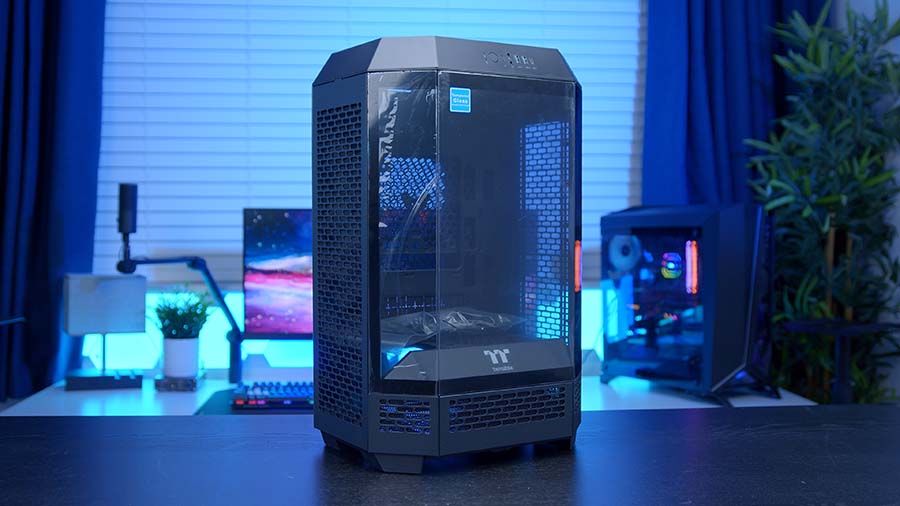
The rest of the chassis is fairly minimalistic on the design front, but the sheer amount of ventilation that Thermaltake have provided is impressive. The airflow capability of this case is a significant improvement versus other small form factor cases, where thermals are normally hindered by a lack of places for hot air to escape, or by compact component spacing.
Building in The Tower 300
Despite The Tower 300 being a smaller chassis, building in it is seamless. We’ve discussed all of the main building qualities and specifications that The Tower 300 has to offer below.
Internal Space
This Micro-Tower case accommodates those looking to build a compact system. In terms of internal space, The Tower 300 supports both Mini-ITX and Micro-ATX motherboards. Micro-ATX boards are a bit of a tighter fit, but not to the point where clearance or building becomes a problem. We found that the open frame design made installing a motherboard much simpler.
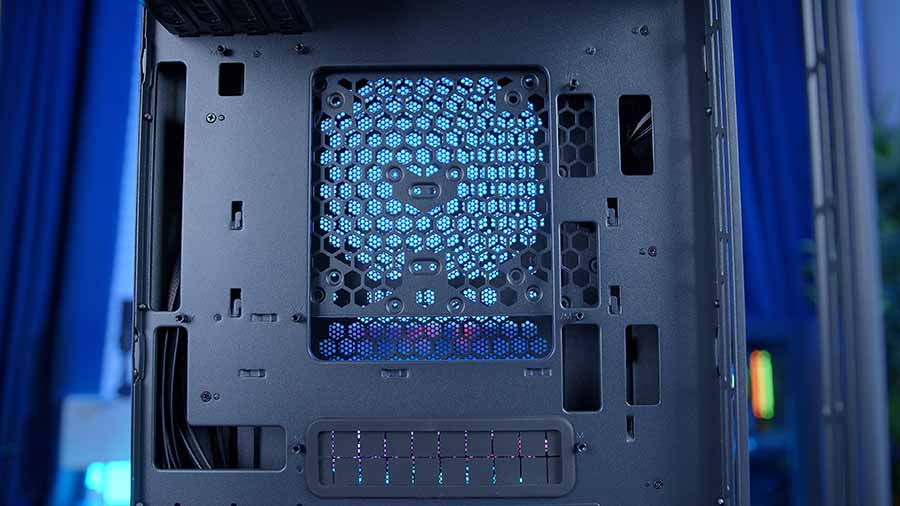
This case provides 210mm of height to play around with for CPU coolers, and 400mm of graphics card clearance. It must be noted, that in order to make use of the 400mm of clearance for your GPU, you’ll have to remove the power cover which is held in with a singular screw.
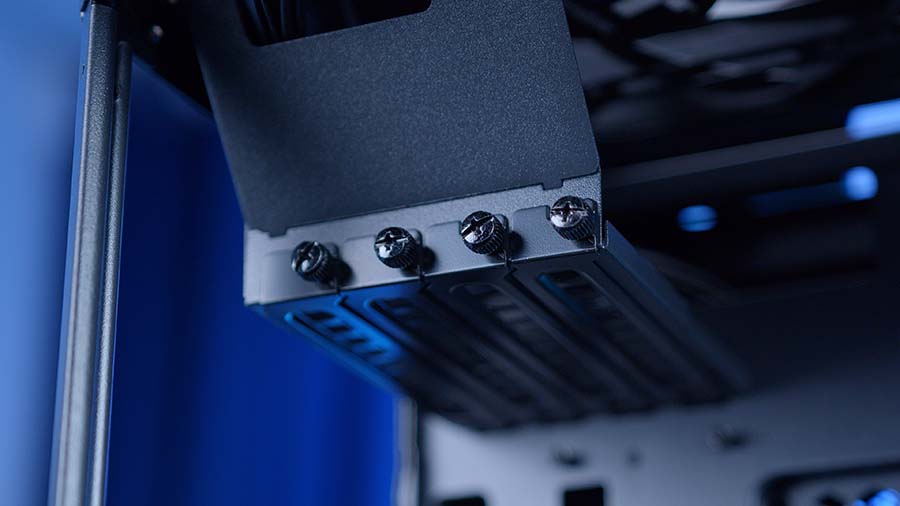
While the Tower 300 can house power supplies up to 220mm in length, cable management is a bit more finnicky due to the overall size. The PSU chamber does have some additional room to hide away your power cables, but jamming them into this space is likely to limit airflow capabilities.
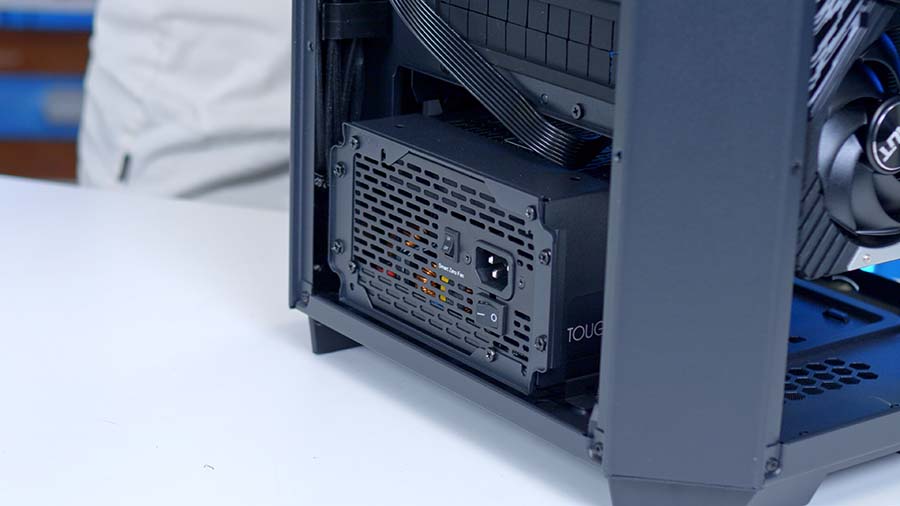
Radiator and Fan Mounting
Because The Tower 300 is a smaller chassis the amount of radiators you can install is more restricted. But despite this, The Tower 300 offers support for 420mm liquid coolers. The mounting for radiators is located on the right hand side of the case.

The Tower 300 has support for up to 8 140mm fans, which is very impressive considering the size of the case. The top, right, rear, and power cover all support 140mm or 120mm sizes, providing a vast number of ways to improve airflow and thermals.
Ease of Building
The Tower 300 is a smaller chassis, so building your PC will always involve some extra steps that you won’t necessarily find with Mid-Tower or Full Tower cases. However, James noted that the building experience with The Tower 300 to be pleasant overall.
The tool-less panels saved time as we weren’t having to constantly screw everything in to get it secured. And this is consistent across the whole design, as the panels that The Tower 300 offers are either magnetic or popped out with a small push. The angular glass panels are also a unique aesthetic feature, rounding out the chassis a bit more and making it less square.
The open frame design made installing additional components very easy. There wasn’t any reason to cram your hands into tight spaces in order to plug in cables or get the radiator mounted.
The removable fan bracket is genius! Being able to install the radiators and fans on a bracket and then simply secure the bracket saves a huge amount of time. Overall, the building experience with The Tower 300 was hassle-free.
Features We Like
Removable Fan Bracket
The radiator/fan mounting bracket located towards the side of The Tower 300 is fully removable. This allows you to easily install your comoonents with minimal hassle, and then secure the bracket to the case afterwards.
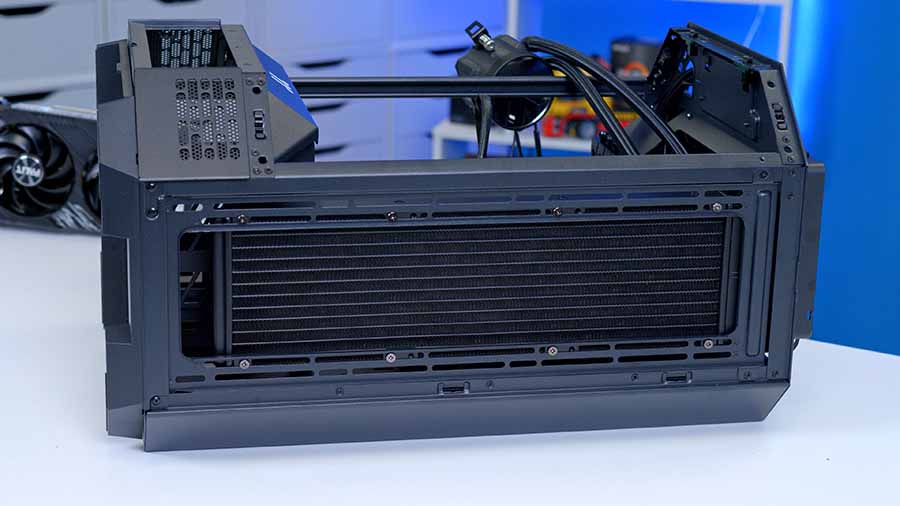
Strong Ventilation
The Tower 300 offers a huge amount of ventilation around the entire case, including the back of the chassis. Thermaltake have done an impressive job here, providing plenty of airflow that spans the whole chassis.
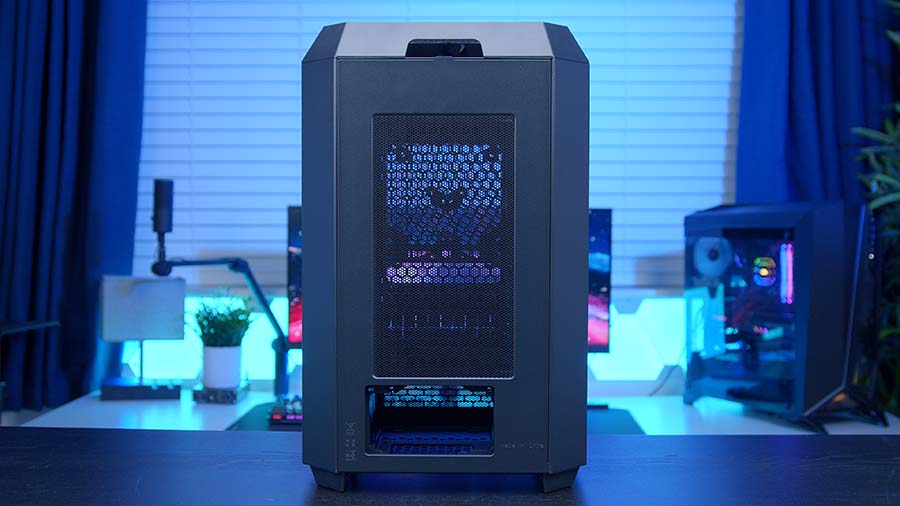
Optional Stand Accessory
The Tower 300 also has an optional stand accessory that can be purchased alongside the case. The stand allows for the chassis to be mounted horizontally which provides an alternative viewing angle for all of your components. What’s more, the feet of the case can be removed and replaced with an additional mesh panel, providing more ventilation.
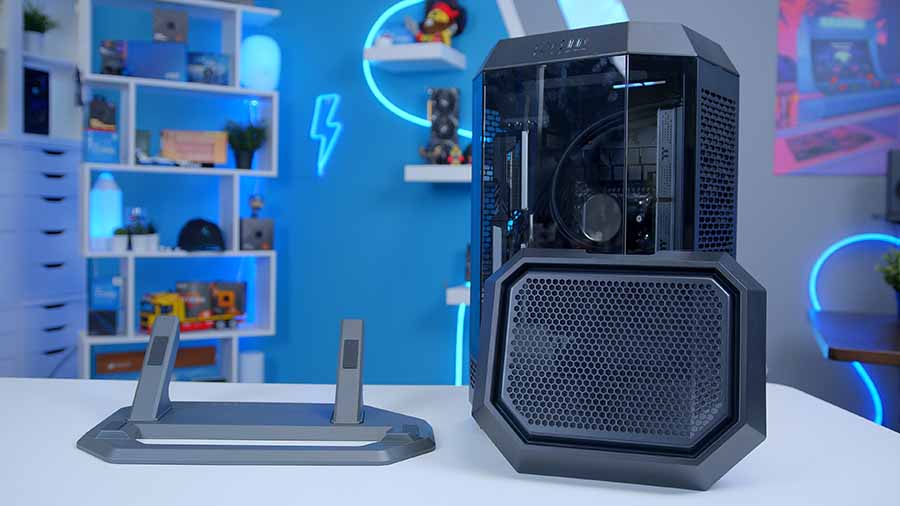
While this stand is totally optional, it serves as a unique way to present your PC build, providing a way to showcase this chassis in an alternative fashion.
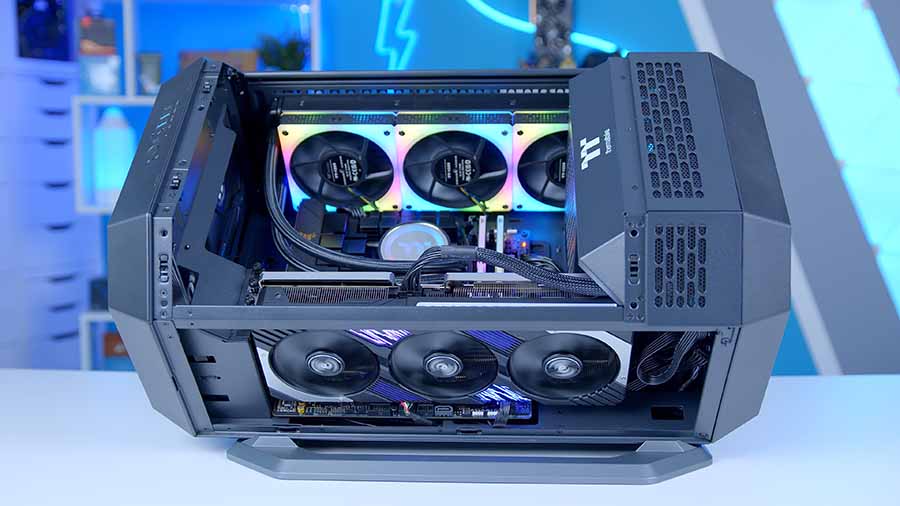
Features We Don’t Like
No Access to the Rear IO
Unfortunately, the biggest caveat to picking up this case, is that you have very limited access to the rear IO. Because your motherboard is positioned horizontally, the rear IO is pointing towards the top of the case, which is sitting underneath the top fan bracket.
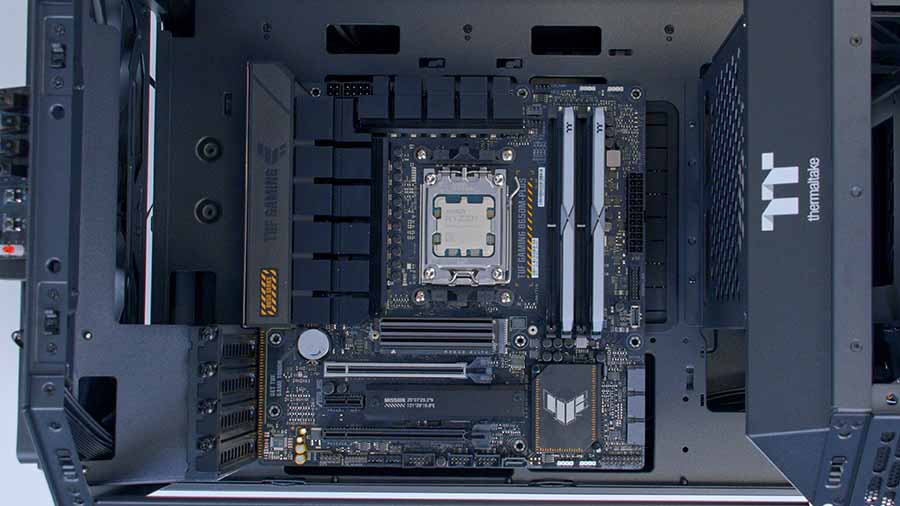
This bracket is removable with thumbscrews, but having to remove the top panel anytime you need to plug in a USB is somewhat of an oversight. While the removable bracket does make this a bit easier, I feel a larger cut-out for your hand to fit through would have been a better solution. If you’re the kind of buyer that needs to constantly chop and change out USB peripherals, this case makes this task considerably more awkward.
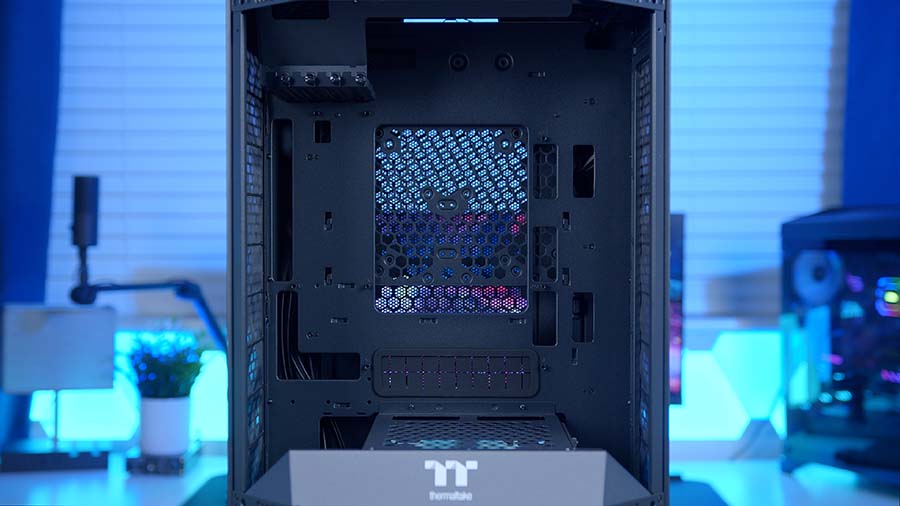
Conclusion
Thermaltake The Tower 300
-
Features
-
Design
-
Versatility
-
Value For Money
Summary
The Tower 300 is Thermaltake’s best iteration of ‘The Tower’ range. With space for a 420mm liquid cooler, 8 140mm fans, and large graphics cards up to 400mm, there is a clear priority on maximising space. This is further complimented by the huge amount of ventilation around the entire case, which aids airflow and circulates heat out of the chassis efficiently. The tool-less panelling design also helps with the building process, and makes building a PC in The Tower 300 very simple.
My only qualm about this case, is the strange choice to limit access to the rear IO. The Tower 300 does not have a direct cut out for the rear IO of your motherboard. This design results in limited access to the rear IO unless the top panel is removed, and the fan mounting bracket is lifted. If there were more front IO ports, this wouldn’t be an issue, but three ports isn’t enough to contend with, if your setup has more than a keyboard, mouse, and headset. While this is an odd design choice, The Tower 300 is a chassis that we’d recommend for those looking to build a PC with a small footprint.
Pros
✅ Ventilation
✅ Competitive price
✅ Tool-less design
Cons
❌ Rear IO accessibility
❌ Lack of pre-installed fans
❌ No RGB


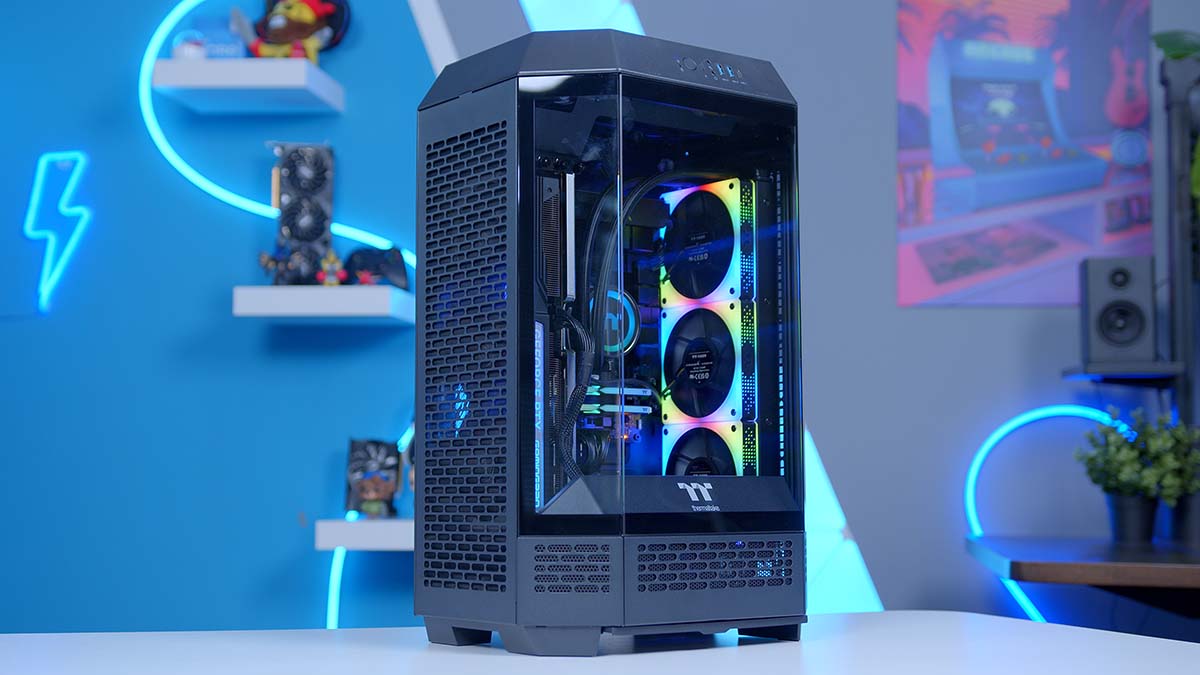
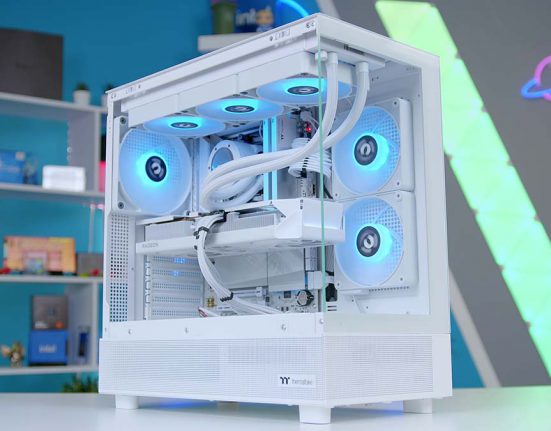
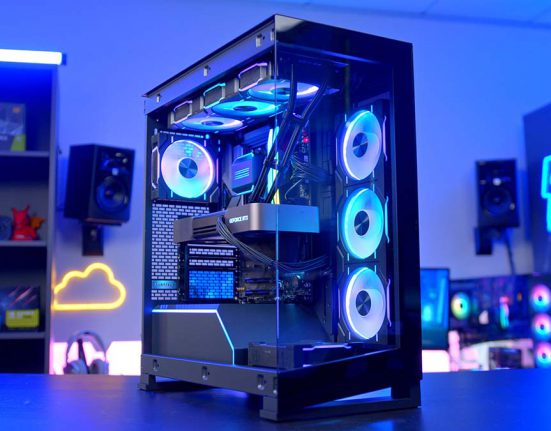
![[AW] Best DDR5 RAM Feature Image - GeekaWhat [AW] Best DDR5 RAM Feature Image](https://www.geekawhat.com/wp-content/uploads/2023/11/AW-Best-DDR5-RAM-Feature-Image-551x431.jpg)
